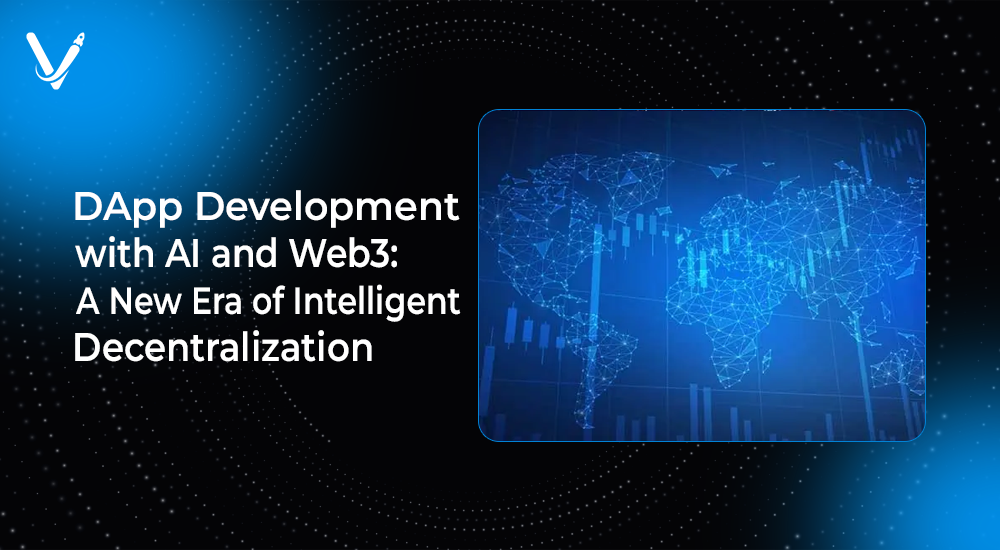DApp Development with AI and Web3: A New Era of Intelligent Decentralization


- Oct 24, 2025



Key Takeaways
The digital world is undergoing a monumental transformation. Artificial Intelligence (AI) and Web3—two of the most disruptive technologies of this century—are converging to redefine how decentralized applications (DApps) are designed, built, and experienced. This convergence signals the rise of intelligent decentralization, where systems are not only distributed but also capable of learning, adapting, and evolving without centralized control.
AI brings intelligence and automation, while Web3 brings transparency and decentralization. Together, they empower applications that can make autonomous decisions, self-optimize, and securely manage data ownership among users. Imagine a decentralized finance (DeFi) app that analyzes market trends in real-time using machine learning, or a decentralized healthcare system that predicts patient needs while keeping sensitive data secure through blockchain encryption.
This isn’t science fiction anymore—it’s the next stage of digital innovation. In this comprehensive guide, we’ll explore how the combination of AI and Web3 is revolutionizing DApp development, what benefits and challenges it presents, and why this fusion is ushering in a new era of intelligent decentralization.
To grasp the impact of AI on DApp development, we first need to understand what decentralized applications truly are and how they differ from traditional software.
A DApp—or decentralized application—is a program that runs on a distributed blockchain network instead of centralized servers. Unlike conventional applications controlled by a single authority, DApps operate through smart contracts—self-executing codes that automatically perform predefined actions when certain conditions are met.
Web3, the underlying ecosystem for DApps, represents the decentralized internet. It prioritizes user ownership, privacy, and transparency by eliminating intermediaries and giving individuals control over their digital assets, data, and identities.
While Web2 was dominated by large corporations storing massive amounts of user data in centralized silos, Web3 shifts the power balance. It introduces tokenized economies, decentralized governance, and trustless interactions—all essential foundations for an intelligent, democratized digital future.
Yet, as powerful as Web3 is, it lacks one vital ingredient—intelligence. This is where AI steps in to elevate DApps from static rule-based systems to dynamic, context-aware, self-learning ecosystems.
Blockchain technology offers transparency, immutability, and decentralization, but it’s inherently deterministic. It follows pre-set rules encoded in smart contracts, unable to adapt or evolve based on changing conditions.
AI, on the other hand, thrives on data-driven learning. It can recognize patterns, predict outcomes, and make intelligent decisions. By integrating AI into DApp development, we enable decentralized systems that can:
In short, AI injects adaptive intelligence into the trustless architecture of blockchain. Together, they create applications that are both secure and smart—capable of operating independently yet intelligently.
This fusion is more than a technological upgrade—it’s a philosophical shift. It moves digital ecosystems toward autonomous decentralization, where intelligent entities operate without intermediaries but still evolve through continuous learning.
The relationship between AI and Web3 is mutually empowering. Web3 decentralization makes AI fairer and more transparent, while AI makes decentralized systems more efficient and user-friendly.
Here’s how the synergy unfolds:
AI brings advanced data analytics and predictive capabilities to blockchain networks. Decentralized systems can leverage AI to:
Blockchain ensures AI transparency by recording data inputs, model changes, and decisions on immutable ledgers. This builds trust in AI-driven decisions, as every step is auditable and tamper-proof.
In essence, Web3 decentralizes trust, while AI decentralizes intelligence. Together, they democratize both control and cognition.
Building intelligent decentralized applications requires a blend of technologies that work harmoniously. Below are the key pillars driving AI and Web3 synergy in DApp development.
Smart contracts automate rules, but AI makes them smarter. For example, an AI-enhanced contract could adjust interest rates in a lending DApp based on real-time market sentiment or user credit behavior, offering a more personalized and fair system.
AI thrives on data, yet traditional AI models depend on centralized data stores. Web3 solves this by introducing decentralized data marketplaces, where users can share, monetize, and control access to their data securely through blockchain verification.
AI models typically require large datasets aggregated in one place. But with federated learning and on-chain AI, models can learn collaboratively across decentralized devices without compromising data privacy. Each node trains the model locally and shares updates without exposing raw data.
AI-driven DApps often integrate utility tokens or governance tokens to incentivize users who contribute data, compute power, or model improvements. This builds a sustainable, self-rewarding ecosystem powered by community participation.
Combining AI with Decentralized Autonomous Organizations (DAOs) leads to intelligent governance systems that make data-informed decisions. AI agents can handle tasks like proposal evaluation, fund allocation, and policy enforcement autonomously while staying transparent on-chain.
When integrated effectively, AI transforms every layer of DApp functionality—from user engagement to backend automation.
AI tailors user experiences by analyzing behavior patterns, transaction history, and preferences. In decentralized social platforms, it can recommend relevant communities or content while respecting user privacy through encrypted on-chain data.
DeFi DApps benefit immensely from AI-driven market forecasting. Machine learning algorithms analyze blockchain activity, sentiment, and liquidity trends to optimize yield farming, staking strategies, and investment portfolios.
AI enhances blockchain’s native security by identifying suspicious patterns and preventing exploits. For instance, anomaly detection models can flag potential rug pulls or malicious contracts in decentralized exchanges.
In supply chain DApps, AI automates tracking, quality verification, and logistics management by interpreting IoT sensor data on-chain. Similarly, in healthcare, AI-powered DApps can automate clinical record matching or predict disease risks securely.
AI-powered chatbots embedded in DApps can offer human-like assistance, simplifying complex processes such as wallet setup, token swaps, or governance voting. This makes DApps more approachable for non-technical users.
The impact of intelligent decentralization extends across diverse industries, redefining business operations and user engagement.
AI optimizes DeFi ecosystems by forecasting price volatility, managing liquidity pools, and personalizing loan terms. Smart trading bots powered by reinforcement learning continuously adapt to market shifts, ensuring higher yield efficiency and reduced risks.
AI-enabled DApps create secure health data ecosystems where patients own their records, and algorithms offer predictive care. Blockchain ensures tamper-proof medical histories, while AI provides diagnosis insights based on anonymized global datasets.
Blockchain ensures traceability, and AI enhances it with real-time analytics. Predictive maintenance, demand forecasting, and logistics optimization can all be automated within decentralized networks, ensuring transparency from producer to consumer.
In decentralized gaming ecosystems, AI powers non-player character (NPC) intelligence, procedural content generation, and in-game economy balance. When combined with blockchain, players can truly own their digital assets while interacting with responsive AI-driven worlds.
AI-powered DApps in real estate can assess property valuations dynamically and manage transactions securely on-chain. In smart cities, decentralized AI systems optimize energy distribution, waste management, and urban planning decisions based on sensor data.
Creating AI-powered decentralized applications involves a layered architecture integrating both on-chain and off-chain components.
This includes smart contracts deployed on blockchain networks such as Ethereum, Solana, or Polygon. They handle transactions, governance, and core logic while maintaining immutability.
AI computations, especially deep learning models, require significant computational resources. Off-chain AI engines process data and return verified outputs to smart contracts through oracles—bridges that securely transmit external data to the blockchain.
Data essential for AI model training and validation is stored on decentralized platforms such as IPFS, Arweave, or Filecoin, ensuring both redundancy and accessibility.
Oracles play a crucial role in connecting real-world data with on-chain systems. AI-enhanced oracles can validate data quality and prevent manipulation, enhancing reliability in DeFi and IoT DApps.
AI-powered DApps feature adaptive user interfaces that personalize dashboards, suggest optimal actions, and provide conversational guidance through NLP-powered assistants.
Together, these layers enable a seamless ecosystem where AI intelligence and blockchain integrity coexist harmoniously.
Despite the promise, building intelligent decentralized applications comes with its share of technical and ethical challenges.
While decentralization ensures data control, AI requires large datasets for training. Striking a balance between privacy and performance through methods like zero-knowledge proofs or differential privacy remains a complex task.
Blockchain transactions can be slow and expensive. Integrating AI workloads can further strain scalability. Layer-2 solutions, sidechains, and off-chain computation frameworks like zk-Rollups are emerging solutions.
Blockchain promotes transparency, but AI decisions can be opaque. Ensuring explainable AI within decentralized environments is critical for trust and compliance.
Connecting multiple blockchains and AI models is challenging. Cross-chain bridges and interoperable data protocols are essential for unified decentralized intelligence.
When AI-driven DAOs make decisions, ethical frameworks must guide fairness, accountability, and bias reduction to prevent misuse of autonomous intelligence.
Despite challenges, the opportunities are immense for forward-thinking enterprises and developers.
Businesses can deploy AI-powered DApps that automate operations like payments, compliance, and customer engagement, reducing overhead and increasing efficiency.
Blockchain ensures every AI decision, transaction, or data update is recorded immutably—enabling traceability and building user trust.
Enterprises can collaborate in data-driven ecosystems without compromising confidentiality, using federated AI on decentralized networks.
Tokenization and AI-driven personalization allow new revenue streams, such as dynamic subscription models, user-driven data marketplaces, and performance-based incentives.
End-users gain full control of their data and digital identities, engaging with personalized, secure, and transparent applications that adapt to their preferences.
While every project is unique, building an AI-integrated DApp typically involves a series of development phases.
Define the problem statement and determine how AI and decentralization together can solve it better than traditional systems.
Choose the right blockchain (Ethereum, Solana, Polygon, etc.) and AI stack (TensorFlow, PyTorch, LangChain) based on scalability and model complexity.
Write and deploy secure smart contracts for transaction logic, governance, and tokenomics.
Develop AI models using decentralized or privacy-preserving data. Deploy off-chain inference systems integrated with blockchain through oracles or APIs.
Conduct rigorous testing for contract vulnerabilities, oracle reliability, and AI output validation. Smart contract audits are essential for trust.
Deploy your DApp to the mainnet and integrate governance mechanisms like DAOs for community-driven improvements and sustainability.
The convergence of AI and Web3 is not a passing trend—it’s a long-term evolution toward self-sustaining digital ecosystems. As quantum computing, IoT, and neurosymbolic AI advance, intelligent decentralization will enable DApps that think, negotiate, and collaborate autonomously.
In the future, decentralized AI networks may form a global collective intelligence, powering financial systems, virtual worlds, and even autonomous organizations without human oversight.
The next decade will see exponential growth in AI-integrated DApps—ranging from self-learning marketplaces and adaptive DeFi ecosystems to autonomous governance systems. This era won’t just redefine how technology works—it will redefine how society functions.
The fusion of AI and Web3 is ushering in an era where decentralization meets intelligence—a world of autonomous, transparent, and adaptive applications. Businesses that embrace this revolution early will lead the digital economy of tomorrow.
Vasundhara Infotech stands at the forefront of this transformation, empowering enterprises to build intelligent DApps that combine AI innovation with Web3’s trust and transparency. Our expertise in blockchain engineering, smart contract architecture, and AI-driven development helps businesses unlock new possibilities in automation, personalization, and scalability.
Ready to build the future of intelligent decentralization? Partner with us and transform your ideas into AI-powered decentralized realities.
5. Why choose Vasundhara Infotech for DApp development?
Vasundhara Infotech combines deep expertise in blockchain, AI, and Web3 technologies to deliver secure, scalable, and intelligent decentralized solutions tailored for your business goals.
Copyright © 2025 Vasundhara Infotech. All Rights Reserved.